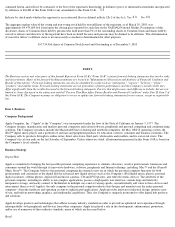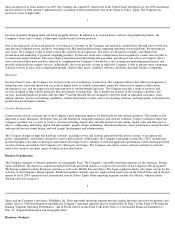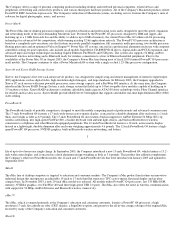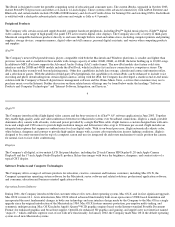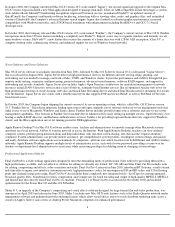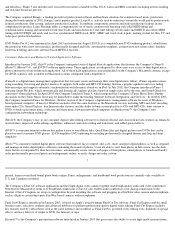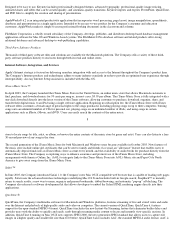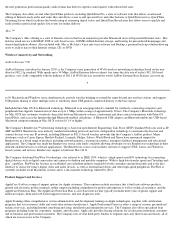Apple 2003 Annual Report Download - page 12
Download and view the complete annual report
Please find page 12 of the 2003 Apple annual report below. You can navigate through the pages in the report by either clicking on the pages listed below, or by using the keyword search tool below to find specific information within the annual report.
many of whom have greater financial, marketing, and manufacturing resources than those of the Company. The Company believes it maintains
a competitive advantage by more effectively integrating the entire end-to-end music solution, including the hardware (iPod), software (iTunes)
and music content (iTunes Music Store).
Raw Materials
Although most components essential to the Company's business are generally available from multiple sources, certain key components
(including microprocessors and application-specific integrated circuits ("ASICs")) are currently obtained by the Company from single or
limited sources. Some other key components, while currently available to the Company from multiple sources, are at times subject to industry
wide availability constraints and pricing pressures. In addition, the Company uses some components that are not common to the rest of the
personal computer industry, and new products introduced by the Company often initially utilize custom components obtained from only one
source until the Company has evaluated whether there is a need for, and subsequently qualifies, additional suppliers. If the supply of a key or
single-sourced component to the Company were to be delayed or curtailed or in the event a key manufacturing vendor delays shipments of
completed products to the Company, the Company's ability to ship related products in desired quantities and in a timely manner could be
adversely affected. The Company's business and financial performance could also be adversely affected depending on the time required to
obtain sufficient quantities from the original source, or to identify and obtain sufficient quantities from an alternative source. Continued
availability of these components may be affected if producers were to decide to concentrate on the production of common components instead
of components customized to meet the Company's requirements. The Company attempts to mitigate these potential risks by working closely
with these and other key suppliers on product introduction plans, strategic inventories, coordinated product introductions, and internal and
external manufacturing schedules and levels. Consistent with industry practice, the Company acquires components through a combination of
formal purchase orders, supplier contracts, and open orders based on projected demand information. Such purchase commitments typically
cover the Company's requirements for periods ranging from 30 to 130 days.
The Company believes there are several component suppliers and manufacturing vendors whose loss to the Company could have a material
adverse effect upon the Company's business and financial position. At this time, such vendors include Agere Systems, Inc., Ambit
Microsystems Corporation, ASUSTeK Corporation, ATI Technologies, Inc., Broadcom Corporation, Compal Corporation, Hon Hai Precision
Industry Co., Ltd., IBM Corporation, International Display Technology, Inventec Appliances Corporation, LG. Phillips Co., Ltd., Matsushita,
Mitsubishi Electric Corporation, Motorola, Inc., Nvidia Corp., Quanta Computer, Inc., Samsung Electronics, Synaptics, Inc., and Toshiba
Corporation.
Research and Development
Because the personal computer industry is characterized by rapid technological advances, the Company's ability to compete successfully is
heavily dependent upon its ability to ensure a continuing and timely flow of competitive products and technology to the marketplace. The
Company continues to develop new products and technologies and to enhance existing products in the areas of hardware and peripherals,
system software, applications software, networking and communications software and solutions, and the Internet. The Company's research and
development expenditures, before any charges for purchased in-process research and development, totaled $471 million, $446 million, and
$430 million in 2003, 2002, and 2001, respectively.
12
Patents, Trademarks, Copyrights and Licenses
The Company currently holds rights to patents and copyrights relating to certain aspects of its computer systems, peripheral systems, and
software. In addition, the Company has registered, and/or has applied to register, trademarks and service marks in the United States and a
number of foreign countries for "Apple," the Apple logo, "Macintosh," and numerous other trademarks and service marks. Although the
Company believes the ownership of such patents, copyrights, trademarks and service marks is an important factor in its business and that its
success does depend in part on the ownership thereof, the Company relies primarily on the innovative skills, technical competence, and
marketing abilities of its personnel.
Many of the Company's products are designed to include intellectual property obtained from third-parties. While it may be necessary in the
future to seek or renew licenses relating to various aspects of its products and business methods, the Company believes that based upon past
experience and industry practice, such licenses generally could be obtained on commercially reasonable terms; however, there is no guarantee
that such licenses could be obtained at all. Because of technological changes in the computer industry, current extensive patent coverage, and
the rapid rate of issuance of new patents, it is possible certain components of the Company's products and business methods may unknowingly
infringe existing patents of others. The Company has from time to time been notified that it may be infringing certain patents or other
intellectual property rights of others.
Foreign and Domestic Operations and Geographic Data
The United States represents the Company's largest geographic marketplace. Approximately 58% of the Company's net sales in fiscal 2003
came from sales to customers inside the United States. Final assembly of products sold by the Company is conducted in the Company's



